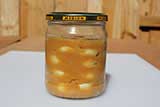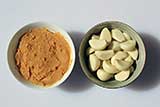Meats and Sausages
Tsukemono
Japanese Tsukemono, or pickled vegetables, covers a wide range of prepared dishes, from slightly fermented cabbage and radishes to garlic marinated in honey. The most common kinds of tsukemono are pickled in salt or brine and they are usually served with rice. Takuan (daikon), umeboshi (ume plum), turnip, cucumber, and Chinese cabbage are among the favorites to be eaten with rice as an accompaniment to a meal. Beni shoga (red ginger) is used as a garnish on okonomiyaki, takoyaki and yakisoba. Gari (ginger) is used between dishes of sushi to cleanse the palate. Rakkyozuke (a type of onion) is often served with Japanese curry. Kombu (seaweed, kelp) is often added. Soy sauce, miso, vinegar, rice bran (nuka), and sake lees (sake kasu), mirin (sweet rice wine) are commonly added for pickling.
Miso is a traditional Japanese seasoning produced by fermenting soybeans with salt and yeast mold known as "koji." It can also be produced from rice, barley or wheat. After fermentation time, ranging from weeks to years, the fermented ingredients are ground into a thick paste similar in texture to peanut butter. Miso is used for sauces and spreads, pickling vegetables or meats, and mixing with dashi soup stock to serve as miso soup called misoshiru, a Japanese culinary staple. Miso ranges in color from white to brown. The lighter varieties are less salty and more mellow in flavor.



















